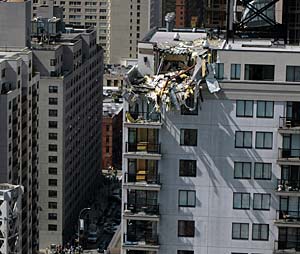A crane collapsed at a Manhattan construction site this morning, killing at least two workers, The New York Times reports. The accident occurred on the Upper East Side, at 91st Street and First Avenue, where a new 34-story condominium tower, the Azure, is rising. The building, designed by SLCE Architects, is being developed by The DeMatteis Organizations and The Mattone Group, according to the Azure Web site. The crane allegedly snapped apart and crashed into a building across the street, a law enforcement official told the Times. New York City Mayor Michael Bloomberg told USA Today, “This is just unacceptable and we’ve got to figure out what happened here.” The accident comes ten weeks after another crane collapsed at a Midtown Manhattan construction site, killing seven people and leading to the resignation of the New York City building commissioner, Patricia Lancaster.


Jean Nouvel was selected Tuesday to design a Paris skyscraper that will rival the Eiffel Tower in height, Agence France-Presse reports. Nouvel, winner of this year’s Pritzker Prize, beat out Foster & Partners and Daniel Libeskind in a competition to design the landmark 71-story, mixed-use building in the city’s La Defense district. At 988 feet tall, Nouvel’s Signal Tower will be only 75 feet shorter than the Eiffel Tower, according to Building Design. The project, scheduled for completion in 2014, calls for nearly 540,000 square feet of office space and 355,000 square feet of residential space, in addition to shops, restaurants, public space, and a hotel. Two other skyscrapers are planned for La Defense, an aging business district the city hopes to revitalize: The Lighthouse by Thom Mayne and the Generali Tower by Valode & Pistre, both expected to be finished in 2012. According to Agence France-Presse, Nouvel designed a skyscraper— “Tower Without End”—for the area in the early 1990s that was never built.
A Philip Johnson-designed house in New Canaan, Connecticut, may be torn down if a suitable buyer doesn’t step forward, according to an article in The New York Times. The 1,773-square-foot Alice Ball House, as it’s called, is regarded as the “livable version” of Johnson’s Glass House, located just a few miles away. Built in 1953 for a single woman named Alice Ball, the light pink stucco and glass house sits on 2.2 acres. The owner, Cristina Ross, an architect and developer, is asking $3.1 million for the house—and has threatened to raze the structure if she can’t find a taker. Ross purchased the property three years ago for $1.5 million. At the time, architectural writer Fred Bernstein predicted the Ball house could face a dark fate. “The buyer, who is an architect, says that she plans to save it. And maybe she will,” he wrote in a piece for the August 2005 issue of Metropolis. “But New Canaanites have reason to be skeptical.”
In related news, the sale of the iconic Kaufmann House, in California, has fallen through, reports The Desert Sun newspaper. The auction house that handled the sale, Christie’s New York, said in an official statement that “the contract has been terminated by the seller by reason of a breach of its terms by the buyer.” The Richard Neutra-designed house, completed in 1946, generated headlines when it sold on May 13 for a reported $16.8 million. Another Modernist dwelling, the Louis Kahn-designed Margaret Esherick House in Pennsylvania, failed to solicit any bids during a May 18 auction.
British architect Richard Rogers has officially pulled out of a high-profile plan to redevelop Manhattan’s main convention hall, theJacob K. Javits Convention Center, according to The Architects’ Journal. Rogers was selected in 2005 to be lead designer of the renovation and expansion project that would nearly double the size of the 790,000-square-foot facility, designed by I.M. Pei & Partners and completed in 1986. Rogers’ withdrawal comes four months after former New York Governor Eliot Spitzer axed the large-scale expansion, opting instead for a 100,000-square-foot addition. According to an article in The New York Observer, architectural fees had incited concern among project overseers. The other two firms on the design team, FXFowle Architects and A. Epstein & Son, are reportedly still working on the project.
The Royal Institute of British Architects announced the winners of its 2008 regional awards program this week. The Westminster Academy, designed by AHMM, was named the “London Building of the Year,” while the Royal Festival Hall renovation, by Allies & Morrison, won in the new “London Public Space” category. The winning projects—in England, Scotland, Northern Ireland, and Wales—are all contenders for RIBA national awards, announced June 27. According to an article in Building Design, the awards program has been criticized for “neglecting classic and traditional architecture.” A complete list of winners are presented on RIBA’s Web site.

Post a comment to this article
Report Abusive Comment